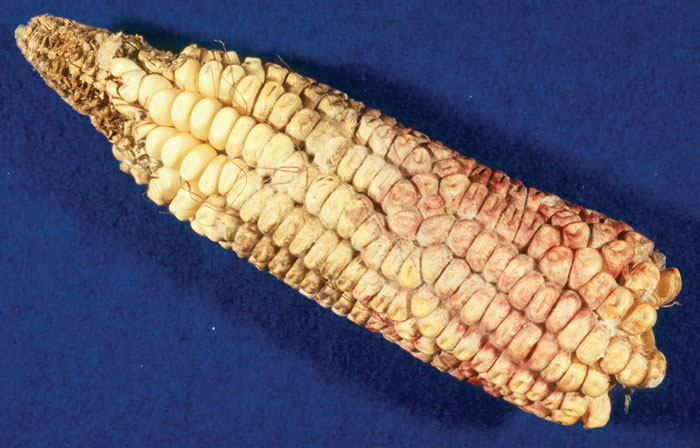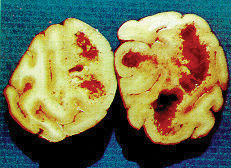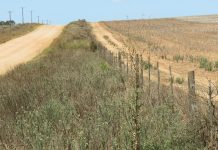
ARC-Grain Crops, Potchefstroom
 Dr Belinda Janse van Rensburg,
Dr Belinda Janse van Rensburg, ARC-Grain Crops, Potchefstroom
The word mycotoxin is derived from the Greek word mykes or mukos, which means ‘fungus’, and the Latin word toxicum which means ‘poison’ – a toxic substance produced by a fungus. Mycotoxins are secondary fungal metabolites that naturally contaminate the human or animal food chain.
Mycotoxins are structurally diverse, naturally occurring, chemical metabolites produced by a wide range of fungi. The growth of fungi and subsequent mycotoxin production, can occur at several levels of the food chain: (1) on crops in the field; (2) during grain storage; (3) during transportation of feeds or crop grains; and (4) during food processing. Mycotoxins are recorded in history as far back as 5 000 years ago in China and may be fatal or cause severe illness at very small concentrations. Following the discovery of carcinogenic aflatoxins, further searches resulted in the identification of more than 100 toxigenic fungi, although only around 30 have true toxic properties of concern. Most common mycotoxins that have been linked to toxic syndromes in livestock and/or humans in South Africa, include aflatoxins, trichothecenes, fumonisins, zearalenone, alternariol and the Stenocarpella maydis associated mycotoxins, which have been implicated in lethal (acute and/or chronic) outbreaks of mycotoxicosis in exposed animals and/or humans.
Exposure to mycotoxins in adequate quantities may cause mycotoxicosis, which affects various processes in exposed animals and/or humans depending on the target organs of the specific mycotoxin. The term mycotoxicosis was used for diseases resulting from the growth of specific fungi in foods and feeds. Mycotoxicosis is generally more frequent in areas where higher levels of humidity and temperature occur, which favour growth of mycotoxin-producing fungi and subsequent mycotoxin production. Exposure to very high amounts of mycotoxins over a short period result in acute toxicity.
Historically, acute mycotoxicosis caused epidemics that intoxicated people or animals in entire areas at the same time. Chronic mycotoxicosis occurs due to the long-term exposure to lower amounts of mycotoxins and affects humans and animals over a long period. Symptoms caused by this exposure are often not noted until it is too late. Locally, mycotoxicosis such as diplodiosis in bovines (caused by Stenocarpella maydis) and pulmonary oedema (caused by fumonisins produced by Fusarium verticillioides) in pigs are the most common acute diseases noted. Various mycotoxicoses may occur in humans and are discussed more specifically under each mycotoxin. However, a host of other mycotoxins which occur at low levels may be responsible for long-term chronic diseases in both livestock and humans.
Fumonisins
Fumonisins are a commonly occurring mycotoxin in maize grain (Photo 1) and are primarily caused by the fungus Fusarium verticillioides. Fumonisins are most common in warm and dry production areas, particularly in the north-western maize growing areas. High levels of fumonisins have a negative effect on consumers of maize grain since they can be carcinogenic to humans and animals. Increased levels of fumonisins in mouldy maize kernels have been statistically linked to human oesophageal cancer and neural tube defects in humans in the former Transkei region in South Africa. It causes brain lesions in horses (Photo 2), pulmonary oedema in pigs (Photo 3) and liver cancer in rats.



In South Africa, fumonisin levels of more than 2 mg/kg were recorded in commercial maize cultivars in the North West and Free State, while only trace amounts were measured in those grown in Gauteng, Mpumalanga and KwaZulu-Natal. An amount of 2 mg/kg is the maximum tolerable daily intake recommended by the Joint FAO/WHO Expert Committee on Food Additives (World Health Organisation, 2002). In September 2016, the South African Ministry of Health has implemented new regulations that allow 2 mg/kg and 4 mg/kg fumonisin for maize flour/meal for human consumption and raw maize, respectively. In rural maize production areas of South Africa, however, much higher fumonisin levels are recorded.
Local researchers have reported fumonisin levels of up to 21,8 mg/kg in Mokopane and Venda (Limpopo), Lusikisiki (Eastern Cape), Mbazwane, Jozini, Pongola and Manguzi (northern KwaZulu-Natal), whereas FB1 levels of up to 117 mg/kg were found in the Centane and Butterworth districts in the former Transkei (Eastern Cape). In Centane, fumonisin levels recorded in home-grown maize were also much higher (1,14 mg/kg)than those found in commercial maize (0,22 mg/kg), although both were still below the allowable legal limits. The difference in fumonisin levels found in maize grown under commercial and resource-poor production systems, might be the result of resource-poor farmers planting home-grown seed from the previous season. Harvested grains used by these producers are not graded in the same manner as commercially produced maize and recommended production practices are not applied. Alternatively, F. verticillioides isolates found in different fields might contribute to the variation in fumonisin levels.
Fusarium graminearum species complex
The two primary trichothecenes are deoxynivalenol (DON) and nivalenol (NIV), which are produced by a range of species within the Fusarium graminearum species complex (FGSC) (Photo 4). Until recently, F. graminearum s.l. was thought to represent a single cosmopolitan species based on morphological species recognition. According to recent research, F. graminearum s.l. now comprises at least 15 species that are biogeographically and phylogenetically distinct to form what is currently referred to as the FGSC. Identification is difficult because these require very specialised techniques to separate and each produces specific mycotoxins. For the purposes of this article, FGSC will be referred to as a group.

Members of the FGSC are known to infect a wide range of plant hosts in both temperate and subtropical regions. They were originally found either as pathogens or secondary invaders of crops, including maize, sorghum, wheat, barley, rice, rye and oats. Over the years, the host range of the FGSC has expanded from cereal to non-cereal crops such as dry beans, canola, potato and soybeans. Studies have shown FGSC to be on the increase – particularly in South African maize production areas. Infected grains can be contaminated with mycotoxins such as DON, NIV and zearalenone (ZEA).
Trichothecenes – DON and NIV
Trichothecenes include DON and NIV. Studies show that NIV is the final product of the trichothecene biosynthesis pathway, while DON is seen as a pathway intermediate. Currently, strain-specific trichothecenes have been identified in the FGSC, namely DON, 3-acetyl deoxynivalenol (3ADON), 15-acetyl deoxynivalenol (15ADON) chemotype and NIV. No single ‘subspecies’ of the FGSC isolates has been found to produce both these trichothecenes, even though ‘subspecies’ are predominant producers of DON or NIV. DON is the most widespread of the trichothecenes and is frequently detected worldwide. Although restricted, NIV has been reported in Africa, Asia and Europe, but not in North America.
These mycotoxins can alter the functioning of the immune system, mitochondria and cell division and affect cell membranes. The crops in which trichothecenes can play a role in animal and human health, are maize, wheat, oats and barley, which influence swine, cattle, horses, rats and humans. The effect of trichothecenes on these animals and humans results in digestive disorders (emesis, diarrhoea, refusal to eat), haemorrhage (stomach, heart, intestines, lungs, bladder, kidney), oedema, oral lesions, dermatitis and blood disorders. The presence of DON in maize-based feeds such as silage increases the risk of health problems in livestock and is associated with poor performance in animal growth and production.
ZEA
In addition to the production of trichothecene mycotoxins, FGSC species are also considered as the primary producers of ZEA. This mycotoxin has been detected in a wide variety of cereal crops, including sorghum, barley, oats, wheat and maize. The co-occurrence of ZEA, DON and NIV are common in cereal crops infected by FGSC. Although the biological potency of ZEA and its metabolites is high, the actual toxicity associated with consumption of food and feed sources contaminated with these compounds is low. Pigs are highly sensitive to this mycotoxin, with as little as 1 µ g/kg (ppb) known to cause detectable uterogenic responses in sows.
Concentrations between 50 mg/kg and 100 mg/kg can interfere with conception, ovulation, implantation, foetal development and the viability of new-born animals. ZEA results in estrogenic effects (oedema of vulva, prolapse of vagina, enlargement of uterus), atrophy of testicles, atrophy of ovaries, enlargement of mammary glands and abortions. Livestock that are fed contaminated cereals transmit this mycotoxin into their meat. ZEA is the potential causal agent for precocious pubertal changes in young children in Puerto Rico.
Conclusion
Mycotoxins result in a number of toxic effects in different animals and in humans. It can be reduced by various means during plant growth and grain storage. Several mycotoxins have been well researched and well understood whereas others have not. Fortunately, the Fusarium spp. mycotoxins have been extensively researched. However, new information is being generated continuously, assisting in improving understanding of these mycotoxins and the role they play in human and animal health.
Anyone interested in finding out more detail on mycotoxins and how to control the diseases that cause these mycotoxins may contact the authors at 018 299 6100.




























